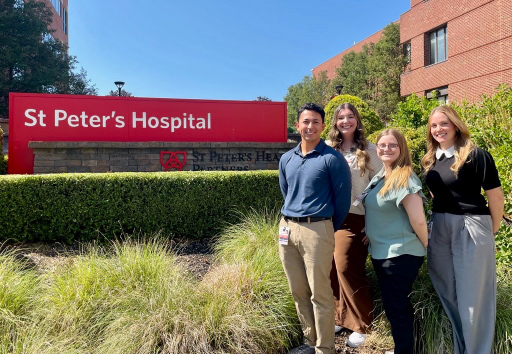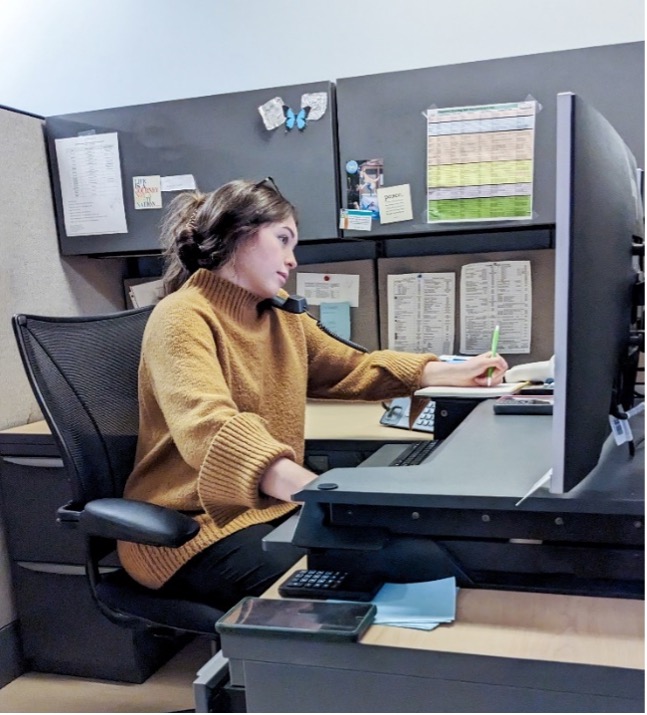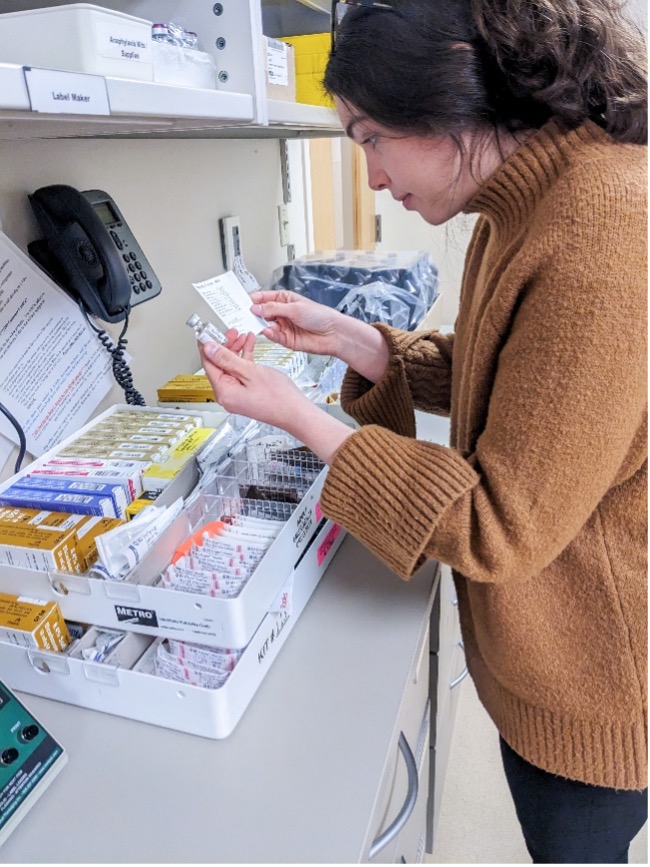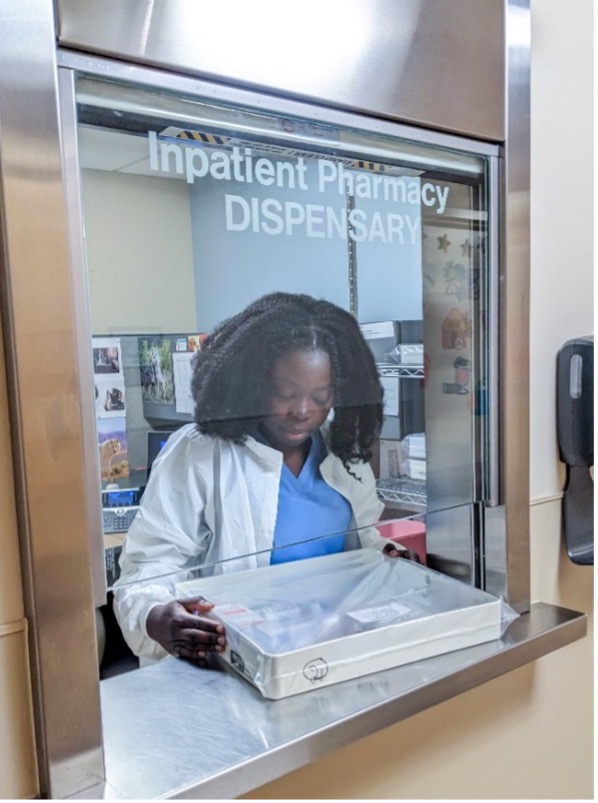Day in the Life of SPH PGY1 Resident

Perspectives from the PGY1 Residents Through the Years
- On Day One
- On Being Chief Resident
- On Introduction to Pharmacy Practice
- On Cardiology/Internal Medicine
- On Critical Care
- On Antimicrobial Stewardship
- On Surgery/Pain Management
- On Pharmacy Practice
- Day 365

Day One
It is Mon., June 26, 2022. I have long awaited to introduce myself as a pharmacy resident. All of us coresidents were finally able to meet in person and are anxiously awaiting Dr. Daniella Rodrigues to give us a brief tour of the hospital. We head down to the pharmacy and meet our residency program coordinator, Dr. Carley Luker, and our director of pharmacy, Dr. Tom Lombardi. We go to our orientation meeting where we discussed hospital policies, our Residency Program requirements, and our Resident Schedule! For a brief intermission, we go to Security and get our badges, which was when it all started to feel real! Over the next few weeks, we had daily training including Epic training, Vancomycin Dosing training, and started our Introduction to Pharmacy Practice Rotation.
By: Amanda Pawlikowski, BS, PharmD, PGY1 Resident
Chief Resident
As residents, we are required to complete quarterly longitudinal rotations in addition to our core rotations. My initial longitudinal rotation is being the chief resident, which involves numerous responsibilities. The primary purpose is to serve as the representative for the four residents and to ensure everything runs smoothly and everyone can navigate easily in the system. The issues that arise are communicated to Daniella, our residency program director, and the solutions are then shared with my fellow residents.
Another responsibility of the chief resident is to coordinate the weekly journal club with pharmacy students who are currently on rotation at St. Peter’s Hospital. The journal club is scheduled to take place every Thursday, with one or two students presenting recently published articles. The chief resident is responsible for facilitating the discussion and evaluating the participating students. Journal club articles are very helpful in promoting awareness of current research findings and help us learn how to critique and assess research.
As a chief resident, I have worked very closely with the program director to update the agenda for our resident development meetings, which are scheduled every week. This is the time for the residents to share updates about rotations, longitudinal requirements, well-being, and discussing approaching deadlines. Additionally, we have scheduled topic discussions, weekly teaching sessions, and we always start the meetings with a fun five-minute activity, which provides a break from clinical duties and serve as a team building activity, The chief resident is responsible for documenting the meeting minutes, which helps to keep track of residents’ progress and assists with planning for the following week.
During the first quarter, the chief resident also assists with updating the residency website and keeping track of deadlines for the ASHP clinical midyear event. This includes tasks like managing meeting registration, adhering to poster requirements, and meeting the abstract submission deadline. All the requirements and deadlines are effectively communicated to my co-residents.
Serving as the chief resident has been a very rewarding experience. It has not only helped me establish a good relationship with my co-residents and program director but has also taught me the importance of effective communication, documentation, and organizational skills. I am looking forward to the upcoming longitudinal learning experiences.
By: Ilvana Zhaka, PharmD, PGY1 Pharmacy Resident
Pre-Admission Testing (PAT)
There are many elements of preparation that need to be completed before a patient is seen for surgery. Pharmacists working in the surgical queue are responsible for preadmission testing (PAT) consults, compounding intraprocedural IV preparations, and replenishing stock within the operating room Pyxis machines. While working in the surgical queue, the patients are followed from each point in their stay. As they are transferred throughout the hospital, we can track and view the exact phase of their care. Medication orders are being prepared and are then released when the patient gets to their post-operation unit. With this system in place, the patient can enter a structured recovery process. I enjoy this queue because it allows the pharmacist to track progress in real time. Many patients can be discharged back home at the end of the day to recover in the comfort of their own home! All members of the team work towards a common goal of providing an environment fit for recovery and rest. Pain services allow us to not only avoid unnecessary use of opioids and other high-risk pain medications, but also adequately treat a person's pain. Pain control regimens should be multimodal if possible, and they should focus on clear criteria for escalation or de-escalation. The pain stewards are highly trained in titrations of opioids, cross titrating to other forms of opioids, and timing the regimens based on their onset and duration of action. It is valuable to have a team of pharmacists who can use equivalent doses to convert between common opioids, check settings for patient-controlled analgesia (PCAs), and recommend regimens for discharge. I enjoy getting the opportunity to alleviate a patient's pain as many patients have debilitating pain conditions that can be a detriment to their course of stay.
When it comes to both of these services, it is so important to be able to reference guidelines, reference documents within patient charts, and communicate with other providers. I feel that this experience allows the resident to get experience with triaging data, making quick and accurate assessment, and streamlining information. I enjoyed building my confidence as a health care provider and even recommending the addition of an agent that could provide benefit.
By: Gabriella Leto, PharmD, PGY-1 Pharmacy Resident
Introduction to Pharmacy Practice
 From pharmacy intern to pharmacist is a shift, both professionally and mentally. It seems so simple being the intern or technician waiting on a product to be verified so you can deliver the medication to the patient. Once you’re the one verifying it and being the “final check”, it seems to be filled with more pressure. Thankfully this inpatient pharmacy experience showed me that I was capable of being that final say, if I trusted what I was doing. At first, I started off slowly and looking over my shoulder for that validation from my preceptor that the order was indeed ok. Then, I found myself looking for the information on my own to ensure that I thought it was ok, still looking for the validation that what I found was substantial. Soon after that, a hovered mouse over the “verify” button turned into a click with certainty. I appreciated this experience as it showed me how different pharmacists work in different queues and reminded me that if I do need more time, there was always someone to back me up. It forces you to develop some independence, without even realizing it. From clarifying orders with providers, asking a nurse to get a scaled weight, or giving recommendations on switches when a patient can’t take medications by mouth, you quickly become more and more self-sufficient. I developed my own way and routine, that still does need a bit of tweaking but is something I can work with. On to the next step! To the clinicals and beyond!
From pharmacy intern to pharmacist is a shift, both professionally and mentally. It seems so simple being the intern or technician waiting on a product to be verified so you can deliver the medication to the patient. Once you’re the one verifying it and being the “final check”, it seems to be filled with more pressure. Thankfully this inpatient pharmacy experience showed me that I was capable of being that final say, if I trusted what I was doing. At first, I started off slowly and looking over my shoulder for that validation from my preceptor that the order was indeed ok. Then, I found myself looking for the information on my own to ensure that I thought it was ok, still looking for the validation that what I found was substantial. Soon after that, a hovered mouse over the “verify” button turned into a click with certainty. I appreciated this experience as it showed me how different pharmacists work in different queues and reminded me that if I do need more time, there was always someone to back me up. It forces you to develop some independence, without even realizing it. From clarifying orders with providers, asking a nurse to get a scaled weight, or giving recommendations on switches when a patient can’t take medications by mouth, you quickly become more and more self-sufficient. I developed my own way and routine, that still does need a bit of tweaking but is something I can work with. On to the next step! To the clinicals and beyond!
By: Nickeshia Rumble, PharmD, PGY1 Pharmacy Resident
Cardiology/Internal Medicine
I start my day around 7 a.m. to prepare for rounds at 8:30 a.m. This preparation involves working up post-surgery patients in the Cardiovascular Intensive Care Unit (CVICU) and the Progressive Care Unit as well. I review their medication lists, pre-operation and post, for any differences and appropriateness of each medication. I also look at their labs to identify any adjustments that may need to be made due to electrolyte imbalance, renal impairment, dietary changes or blood work. Any interventions that I feel should be made or questions that I may have, I can discuss with my preceptor, or bring up during rounds which are usually with case workers, cardiothoracic surgeons, nurse practitioners, physician assistants and nurses. Although each one is focused on a different aspect of the patient’s wellbeing, our collective goal is getting the patient healthy enough to return home or to rehabilitation where they can get more care if needed.
After rounds, I continue reviewing patients on our main floors to assess the appropriateness of their therapy as well. Some patients may be able to transition from intravenous therapy to taking medications by mouth. Some patients may require a renal dose adjustment of their medications due to improving or declining kidney function. Some patients may require anticoagulation for prevention of a venous thromboembolism. These are only some of the things we look for while reviewing patients, with the same goal of complete healthcare.
Throughout the day, providers may request consults for the pharmacy team to assist with medication reconciliations, pain assessments, antibiotic dosing, etc. We review those as well and monitor/adjust vancomycin and aminoglycoside orders. It is a busy day, but you are always supported by your coworkers and preceptors.
By: Nickeshia Rumble, PharmD, PGY-1 Pharmacy Resident
Critical Care
 Each day in the Intensive Care Unit (ICU) brings new experiences and challenges. The environment is fast-paced, and there is a wide range of disease states to assess simultaneously. I arrive before sunrise and print a list of patients on the floor to prepare for the day, determine their status, and see if changes occurred overnight. I also review the provider's assessment and plan to see if the medications on the profile are indicated and dosed appropriately. Learning to use your resources is necessary to provide quality care and proper assessment.
Each day in the Intensive Care Unit (ICU) brings new experiences and challenges. The environment is fast-paced, and there is a wide range of disease states to assess simultaneously. I arrive before sunrise and print a list of patients on the floor to prepare for the day, determine their status, and see if changes occurred overnight. I also review the provider's assessment and plan to see if the medications on the profile are indicated and dosed appropriately. Learning to use your resources is necessary to provide quality care and proper assessment.
Participating in morning rounds is an excellent opportunity to get to know the providers, anticipate where you can be helpful, and offer input on treatment that is team-oriented.
Overall, the experience you will acquire in the ICU will push you to go out of your comfort zone, teach you to use your resources, and give you great practice in treating infectious diseases, hemodynamic instability, acute coronary syndromes, trauma, and more. You will learn the hospital's layout very fast, as you must respond to code situations when called and become ACLS certified before starting this rotation. I will always look back on my time in the ICU and appreciate the experiences as they have taught me about the importance of integrity, urgency, compassion, and empathy.
By: Caroline DuMoulin, PharmD, PGY-1 Pharmacy Resident
Surgery/Pain Management
I usually start my day around 8:00 a.m. I like to get in early so I can address any outstanding issues from the previous workday. The first thing that I do is check the queue. This is where I will find the majority of my clinical responsibilities, including requests for pain management or surgical consults, preadmission testing (PAT) consults, and medication reconciliation requests. Requests for pain management consults are generally made for opioid-tolerant patients who have undergone surgery and are in need of modification of their home regimens in order to compensate for this new acute pain from the procedure. However, there may be other situations where we would get called for a pain consult, such as in patients with continuously poor pain control despite escalation of their current regimen. These consults will involve going up to the floors to ask patients about their pain. Things we want to know may include where their pain is coming from, when their new acute pain started, what has made it better or worse, how long relief from their current medications lasts, and so on. This information helps us formulate our recommendations to optimize the patient’s pain control to the doctor.
PAT consults involve reviewing an opioid tolerant patient’s chart prior to elective surgery to make postoperative pain management recommendations. In doing this, we will consider the dose the patient currently receives and anticipate an increased requirement due to the imminent procedure. A request for a medication reconciliation will be made for a variety of reasons. These opportunities give us the ability to rectify any issues or discrepancies between the patient’s home medications and what they are receiving in the hospital. Other tasks include checking the surgery schedule for patients undergoing bariatric procedures. For these patients, we will need to identify which of their medications may be crushed and suggest appropriate alternatives for those which may not.
At this point, I make note of how many tasks are already waiting for me, knowing that this number will likely grow by the time I begin to work on them. I then take about 30 minutes to review my patients from the previous few days who I’ve determined I need to follow up on. This is an important step to take to see if your recommendations have been accepted and, if they have, ensure that they are working. It also provides you the opportunity to recognize any changes in the patient’s status, which may impact the safety of what you’ve recommended. Once I’ve done this, I work up my new patients, make note of any issues on my old patients that need to be addressed, and move up to the floors for another busy day!
By: Mitchell Miller, PharmD, PGY-1 Resident Graduate
Day 365
Before I started my residency, I was nervous about the challenges I knew this year would bring me. Everyone I had spoken to told me that this year would go by quickly and I would learn a lot of clinical information. Although parts of this year were challenging and we spent the whole year navigating not only the challenges of residency, but also the challenges of working in a hospital during a pandemic, I truly believe this past year was instrumental in facilitating my transition from student to independent practitioner. Not only did my residency class and I learn through clinical rotations, longitudinal rotations, and staffing, but also through helping run our COVID-19 vaccine clinic. Whenever challenges came up, we sought to use these experiences as opportunities for growth and have become better pharmacists in the process. Over time, this helped me build up confidence, and the nervousness I had before residency went away.
Looking back at the year, I feel fortunate to have been provided preceptors that have become lifelong mentors and coresidents that became lifelong friends. To those just beginning the year or considering residency at St. Peter's hospital, I feel confident that this residency program prepares you for whatever the next steps of your career may be.
By: Alice E. Thomasson, PharmD, PGY1 Pharmacy Resident Graduate
